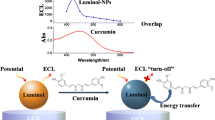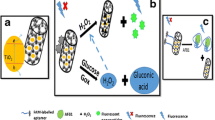Abstract
We describe a substantial improvement of the electrochemiluminescence (ECL) of luminol which is widely used in flow injection analysis (FIA). It is based on synchronous dual sensitization of ECL by using titania nanotubes (TiNTs) and platinum black (PB). A piece of indium tin oxide (ITO) glass functionalized with TiNTs acts as the first working electrode, and a PB-modified platinum plate serves as the second one. By applying two constant potentials to the two electrodes, strong and consecutive ECL emission of luminol is obtained. The system works well in assays as shown for the successful quantitation of hydrogen peroxide (H2O2), of the antioxidant resveratrol, and of the neutrotransmitter dopamine (DA) in spiked human serum samples. The detection limits for these three species (at a signal-to-noise ratio of 3) are as low as 66 pM (H2O2), 22 nM (resveratrol), and 30 nM (DA). Recoveries in assays of DA in spiked serum range from 97.3 to 105.4 %. In our perception, the technique of dual sensitization represents a substantial improvement of the detection limits of ECL assays.

A substantial improvement of the electrochemiluminescence (ECL) of luminol was accomplished by synchronous dual sensitization of ECL with using titania nanotubes and platinum black.



Similar content being viewed by others
References
Miao WJ (2008) Electrogenerated chemiluminescence and its biorelated applications. Chem Rev 108:2506–2553
Richter MM (2004) Electrochemiluminescence (ECL). Chem Rev 104:3003–3036
Du SP, Guo ZY, Chen BB, Sha YH, Jiang XH, Li X, Gan N, Wang S (2014) Electrochemiluminescence immunosensor for tumor markers based on biological barcode mode with conductive nanospheres. Biosens Bioelectron 53:135–141
Afsaneh S, Alireza B, Fatemeh S (2013) Synthesis of palladium nanoparticles on organically modified silica: application to design of a solid-state electrochemiluminescence sensor for highly sensitive determination of imipramine. Anal Chim Acta 796:115–121
Muzyka K (2014) Current trends in the development of the electrochemiluminescent immunosensors. Biosens Bioelectron 54:393–407
Wu L, Wang JS, Yin ML, Ren JS, Miyoshi D, Sugimoto N, Qu XG (2014) Reduced graphene oxide upconversion nanoparticle hybrid for electrochemiluminescent sensing of a prognostic indicator in early-stage cancer. Small 10:330–336
Xu SJ, Liu Y, Wang TH, Li JH (2010) Highly sensitive electrogenerated chemiluminescence biosensor in profiling protein kinase activity and inhibition using gold nanoparticle as signal transduction probes. Anal Chem 82:9566–9572
Chen YY, Tu YF (2014) The enhanced electrochemiluminescence of luminol by resonance energy transfer with solid-phase CdTe quantum dots. Electrochim Acta 135:187–191
Chen M, Wei XH, Tu YF (2011) A luminol-based micro-flow-injection electrochemiluminescent system to determine reactive oxygen species. Talanta 85:1304–1309
Liu C, Wei XH, Tu YF (2013) Development of a reagentless electrochemiluminescent electrode for flow injection analysis using copolymerised luminol/aniline on nano-TiO2 functionalised indium-tin oxide glass. Talanta 111:156–162
Wei XH, Liu C, Tu YF (2012) Microemulsion-enhanced electrochemiluminescence of luminol-H2O2 for sensitive flow injection analysis of antioxidant compounds. Talanta 94:289–294
Yu ZM, Wei XH, Yan JL, Tu YF (2012) Intensification of electrochemiluminescence of luminol on TiO2 supported Au atomic cluster nano-hybrid modified electrode. Analyst 137:1922–1929
Wei XH, Xiao CB, Wang K, Tu YF (2013) A nano-TiO2 supported AuAg alloy nanocluster functionalized electrode for sensitizing the electrochemiluminescent analysis. J Electroanal Chem 702:37–44
Wang K, Wei XH, Tu YF (2014) Strong enhancement of the electrochemiluminescence of luminol by AuAg and PtAg alloy nanoclusters, and its sensitization by phenolic artificial oestrogens. Microchim Acta 181:1223–1230
Hong J, Ming L, Tu YF (2014) Intensification of the electrochemiluminescence of luminol on hollow TiO2 nanoshell-modified indium tin oxide electrodes. Talanta 128:242–247
Cui H, Zou GZ, Lin XQ (2003) Electrochemiluminescence of luminol in alkaline solution at a paraffin-impregnated graphite electrode. Anal Chem 75:324–331
Cui H, Xu Y, Zhang ZF (2004) Multichannel electrochemiluminescence of luminol in neutral and alkaline aqueous solutions on a gold nanoparticle self-assembled electrode. Anal Chem 76:4002–4010
Cui H, Zhang ZF, Zou GZ, Lin XQ (2004) Potential-dependent electrochemiluminescence of luminol in alkaline solution at a gold electrode. J Electroanal Chem 566:305–313
Ming L, Peng TT, Tu YF (2014) A new strategy for exciting the electrochemiluminescence of luminol by double-static potential. Electrochem Commun 46:107–110
Peng TT, Ming L, Tu YF (2015) A new designed cell for luminol based electrochemiluminescence by bi-potentiostatic excitation for flow-injection analysis. J Electroanal Chem 738:8–13
Chu CC, Li M, Ge SG, Ge L, Yu JH, Yan M, Song XR, Li L, Han BH, Li JX (2013) “Sugarcoated haws on a stick”-like MWNTs-Fe3O4-C coaxial nanomaterial: synthesis, characterization and application in electrochemiluminescence immunoassays. Biosens Bioelectron 47:68–74
Liu WY, Ma C, Yang HM, Zhang Y, Yan M, Ge SG, Yu JH, Song XR (2014) Electrochemiluminescence immunoassay using a paper electrode incorporating porous silver and modified with mesoporous silica nanoparticles functionalized with blue-luminescent carbon dots. Microchim Acta 181:1415–1422
Zhong X, Chai YQ, Yuan R (2014) A novel strategy for synthesis of hollow gold nanosphere and its application in electrogenerated chemiluminescence glucose biosensor. Talanta 128:9–14
Deng WP, Chu CC, Ge SG, Yu JH, Yan M, Song XR (2015) Electrochemiluminescence PSA assay using an ITO electrode modified with gold and palladium, and flower-like titanium dioxide microparticles as ECL labels. Microchim Acta 182:1009–1016
Grover IS, Singh S, Pal B (2013) The preparation, surface structure, zeta potential, surface charge density and photocatalytic activity of TiO2 nanostructures of different shapes. Appl Surf Sci 280:366–372
Kowalski D, Kim D, Schmuki P (2013) TiO2 nanotubes, nanochannels and mesosponge: self-organized formation and applications. Nano Today 8:235–264
Liu N, Chen XY, Zhang JL, Schwank JW (2014) A review on TiO2-based nanotubes synthesized via hydrothermal method: formation mechanism, structure modification, and photocatalytic applications. Catal Today 225:34–51
Lin YY, Dai H, Xu GF, Yang T, Yang CP, Tong YJ, Yang YS, Chen GN (2013) Enhanced luminol electrochemiluminescence triggered by an electrode functionalized with dendrimers modified with titanate nanotubes. Microchim Acta 180:563–572
Dai H, Chi YW, Wu XP, Wang YM, Wei MD, Chen GN (2010) Biocompatible electrochemiluminescent biosensor for choline based on enzyme/titanate nanotubes/chitosan composite modified electrode. Biosens Bioelectron 25:1414–1419
Ming L, Xi X, Liu J (2006) Electrochemically platinized carbon paste enzyme electrodes: a new design of amperometric glucose biosensors. Biotechnol Lett 28:1341–1345
Zhao JJ, Guo WY, Li JJ, Chu HH, Tu YF (2012) Study of the electrochemically generated chemiluminescence of reactive oxygen species on indium tin oxide glass. Electrochim Acta 61:118–123
Chen XM, Lin ZJ, Cai ZM, Chen X, Oyama M, Wang XR (2009) Electrochemiluminescence of luminol on a platinum-nanoparticle-modified indium tin oxide electrode in neutral aqueous solution. J Nanosci Nanotechnol 9:2413–2420
Chu HH, Guo WY, Di JW, Wu Y, Tu YF (2009) Study on sensitization from reactive oxygen species for electrochemiluminescence of luminol in neutral medium. Electroanalysis 21:1630–1635
Acknowledgments
This work is supported by the National Natural Science Foundation of China (21175096, 21375091); The Project of Scientific and Technologic Infrastructure of Suzhou (SZS201207).
Author information
Authors and Affiliations
Corresponding authors
Electronic supplementary material
Below is the link to the electronic supplementary material.
ESM 1
(DOC 714 kb)
Rights and permissions
About this article
Cite this article
Ming, L., Peng, T. & Tu, Y. Multiple enhancement of luminol electrochemiluminescence using electrodes functionalized with titania nanotubes and platinum black: ultrasensitive determination of hydrogen peroxide, resveratrol, and dopamine. Microchim Acta 183, 305–310 (2016). https://doi.org/10.1007/s00604-015-1614-5
Received:
Accepted:
Published:
Issue Date:
DOI: https://doi.org/10.1007/s00604-015-1614-5




